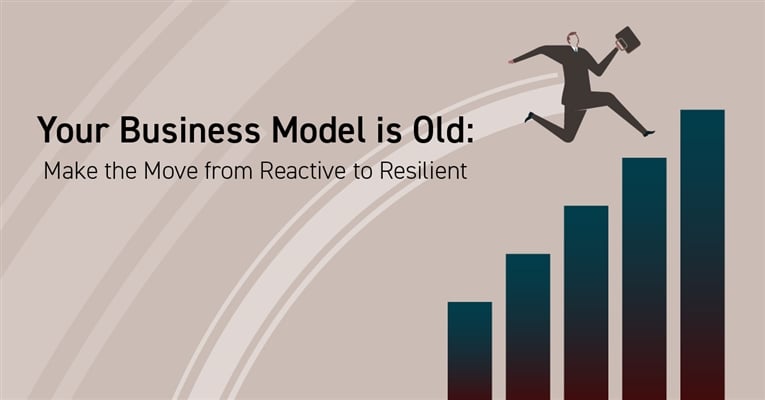Making the move from a reactive business model to a resilient one means you are creating an environment capable of adapting quickly when your business needs to change dramatically, or sequentially over time. The move toward resilience shouldn’t be painful. If you have the right team and technology in place your organization should be salivating at the challenge because they have the tools and processes to make it happen.
While ongoing business demands continue to change and enhance our systems, the past has taught us that we are slowly backing ourselves into a corner when it comes to technology. Over time, as business requirements change, we nip and tuck our systems to make them work a little longer. While this may not be the best approach, it gets the job done so the business can keep running. Not with a strategic advantage mind you, but enough to hit the business goals and objectives for the next 6 months or a year – however, becoming internally focused this way makes you a target for disruption.
If this rings true for you, your business model is old and the changes you think you are making are in reality small in comparison to the real job that needs to be done. The big changes you need do not just require ideas from the few, but collaboration by the many stakeholders inside and outside your organization. This may seem like a daunting task, but here are some examples of organizations making big changes and moving from reactive to resilient successfully.
Industries in transition
NuScale is taking a whole new approach to nuclear power. Instead of building reactors on-site, they have designed a small modular reactor (SMR) which is built and assembled in a factory and then transported to the site for final installation. They are the first SMR to receive Nuclear Regulatory Commission (NRC) approval. Their unique, self-contained modular reactors are capable of generating 60 megawatts of electricity and can be combined with other modules (up to 12 total) in a single power plant. NuScale’s first plant is slated to begin operation in the U.S. in 2026. NuScale selected a solution that could bring groups together across the product lifecycle to support a continuous digital thread, ultimately creating a digital twin so that product information can be linked to support customer requirements and compliance needs. You can read more about it here.
Kendrion was managing multiple systems across three divisions, one of which was approaching its end of life. Previous acquisitions added tools and processes that needed to be integrated. In order to digitally transform, Kendrion sought a solution that could provide a single product lifecycle management (PLM) environment and implement a digital thread to enable traceability throughout the product development process. As a result, Kendrion will be able to map requirements to engineering, increase reuse of information, reduce dependency on manual spreadsheet-based processes, and enhance visibility of all product information. Read our press release, Kendrion Selects Aras Enterprise SaaS for Single Digital Backbone to learn more.
Technip Energies, a leading engineering and technology company has selected Aras as its platform to advance its energy transition strategy and will deploy Aras Enterprise SaaS to achieve full data-centric deployment of its project methods and tools.
Aligned with Technip Energies’ digital-by-design approach which aims to achieve full project lifecycle traceability and optimization from concept through design, execution and operations, this collaboration will increase efficiency and create new opportunities in the energy industry. It will power the scale-up of Technip Energies’ digital project execution practices into a single project platform, leading to standardized data flows and seamless collaboration between disciplines and easy access to past project information to increase engineering re-use, reduction of cycle time, data integration for actionable reporting, and creation of a digital twin backbone. More details can be found here.
Building resiliency requires flexible technology
So, if they can do it, so can you! To understand if you have the right solutions in place to move from reactive to resilient, we created the following set of questions. If you answer ‘no’ to any of these – it’s time to break free from the technology and processes that are holding you back:
- Is your platform customizable? Once customized, can you upgrade easily and without data loss?
Look for a platform with underlying technology that is flexible, scalable, and upgradeable—even when heavily customized. - Does your platform enable the creation of an end-to-end Digital Thread?
It is critical that solutions sustainably connect data throughout the entire lifecycle—breaking down information silos and fostering collaboration. - Does your platform give you the flexibility to meet process requirements that don’t exist today?
Out-of-the-box software may be able to meet today’s needs but the digital processes of tomorrow don’t exist today. Solutions should offer flexible customization to meet ever-changing needs without sacrificing upgradeability. - Does your platform give you total data transparency?
Its your data, you should own it instead of leaving it captive to aging technology or a software vendor’s native software. - Does your “platform” provider try to make you fit their single deployment model?
There should be choice when it comes to deployment. On-premise, in a data center, in the Cloud, or a combination for a hybrid deployment. Whatever works best for YOU! - Can your “platform” evolve technically?
Solutions should evolve over time and adapt to new and improved technology without extensive redesign efforts.
Bottom line, if your technology is not (1) transparent - as technology changes, the data inside the technology does not, (2) evolvable – solution selection doesn’t lock you into one specific technology, and (3) adaptable - supporting and embracing constant change, it will take too long to break your out of your old and outdate business model.
To make the change, start by reading Digital Transformation: Software Obsolescence is Killing Your Business


